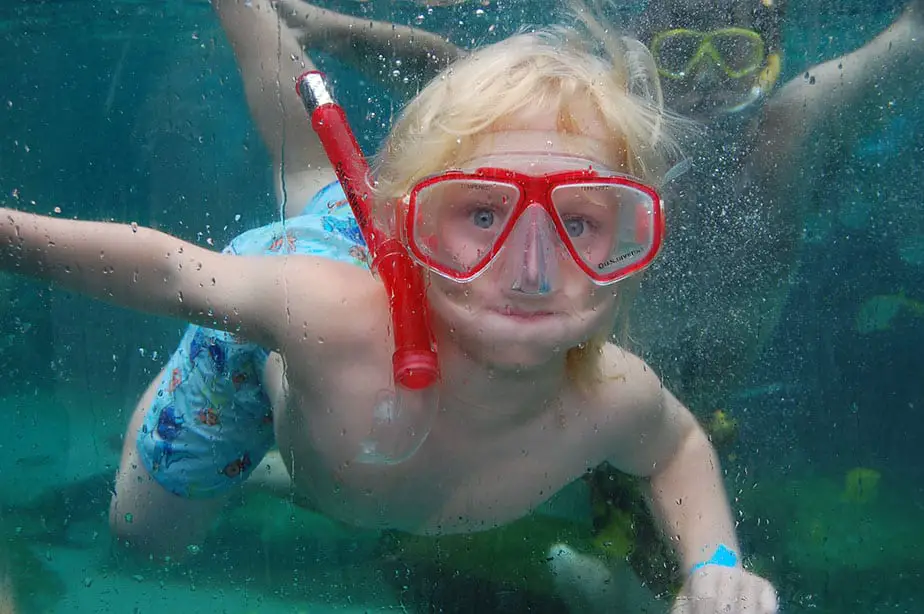If you and your kids are tired of the same old beach routine of collecting shells, building sandcastles, and swimming, then perhaps it’s time to teach them how to snorkel. Snorkeling with kids might sound like a tough activity at first, but all you need to get started is a snorkel, mask, fins, and an adventurous spirit.
Plus, once you see your kids’ eyes open wide with amazement at the colorful ocean reefs teeming with marine life, you’ll know that it was worth it. It’s also loads of fun for the entire family. Parents snorkeling with kids for the first time should keep some tips in mind to ensure that the vacation goes smoothly. In this article, we will provide parent-approved pointers for snorkeling with kids.
Should I go snorkeling with my kids?
When they look back, your children will appreciate the memorable family trips they had when they were younger. Plus, snorkeling is fun for everybody involved, including the parents. After all, being able to breathe underwater like a fish is a cool thing to experience. Even better, the whole family gets to experience a whole new world unlike anything they’ve seen before.
If you’re wondering whether snorkeling is easy enough for kids, keep in mind that if your child is old enough to swim, then they are old enough to snorkel. There isn’t a minimum age for snorkeling per se, however many parents have successfully taken children as young as four and five years old snorkeling, so age is not an issue.
On top of that, snorkeling is a relatively cheap hobby. All you really need for equipment is a mask and snorkel. Having snorkeling fins is highly recommended for more powerful kicks, but ultimately it’s optional. If your kids will be snorkeling in water that’s deeper than their height, then some kind of flotation device is also necessary. All of this can be purchased for around $100.
In case you’re still worried about whether snorkeling is a safe activity for kids, read on to learn how to teach your kids how to snorkel, how you can help make the experience safer, and where are the best snorkeling destinations so that you can make unforgettable memories together as a family.
How to introduce snorkeling to your kids
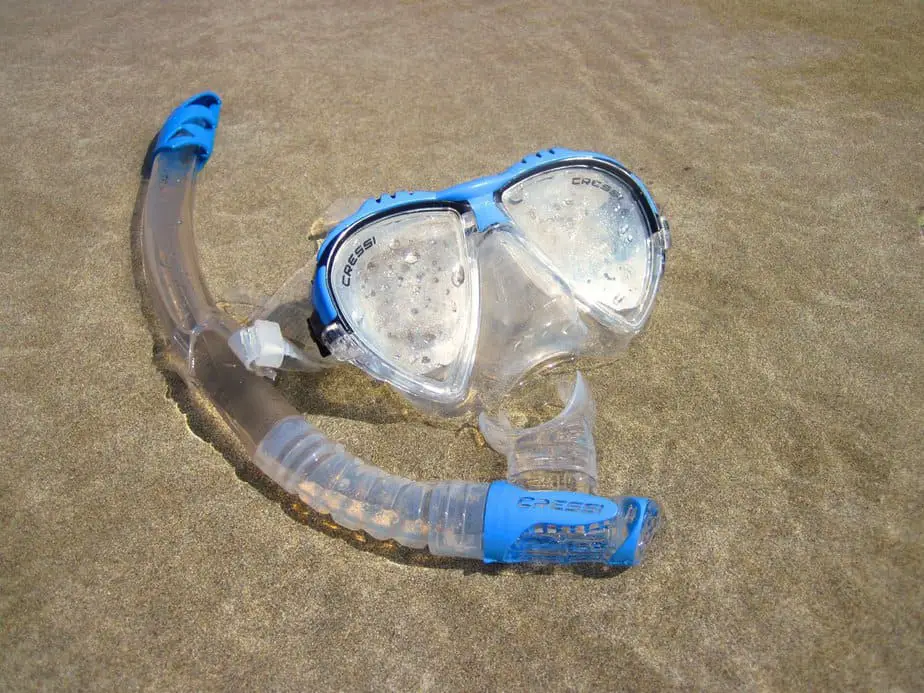
Ideally your child should already know how to swim before they start snorkeling, otherwise they will find being in the water to be a harrowing experience. They do not have to be particularly strong swimmers as long as they know how to stay afloat, stay in shallow waters, and are wearing a snorkel vest.
They will also need to have a properly-fitting mask and snorkel. These are the bare minimum for snorkeling gear, however many snorkelers also like to wear fins to help them explore a larger area.
Getting the right fit
Before taking your child out to the ocean, it’s a good idea that they first practice using their mask and snorkel in a confined environment such as the bathtub or pool. Take this opportunity to also test how well the mask and snorkel fits.
The first thing to do is to test how well the snorkel mask fits. The mask skirt of the dive mask should comfortably grip the face, cover the eyes and nose, and form a seal so that water will not enter. Adjust the mask strap so that the mask fits snug without being too tight. If the strap is digging into their skin, it’s too tight.
Next you need to test how well the snorkel fits. The snorkel can only be attached to a snorkel or dive mask which is why swimming goggles cannot be used. If the weight of the snorkel causes the mask to lose its watertight seal, then the mask needs to be tighter or the snorkel is too big for the mask.
After attaching the snorkel to the mask, your child should test out the mouthpiece. If the mouthpiece is too large, then it will be uncomfortable to hold for long. If it’s too small, then it will be exhausting trying to keep it in place. When the fit is just right, your child will be able to wear it for a long time without feeling pain or fatigue.
Practice in the bathtub or pool
Now that you’re sure the gear fits properly, your child can finally practice using them. This may be the first time your child has ever tried breathing underwater. Also, they will have to adjust to breathing using only their mouth instead of their nose. This is the perfect time for them to practice breathing underwater using the snorkel.
If the mask leaks within a few seconds, then it means that the seal isn’t tight enough. This can be easily fixed by tightening the mask. Mask leaks can and do occur and as long as they are infrequent, then the fit is still considered acceptable. In rare cases, the mask simply does not fit your child’s facial structure and perhaps a new mask is needed.
Wear a flotation device
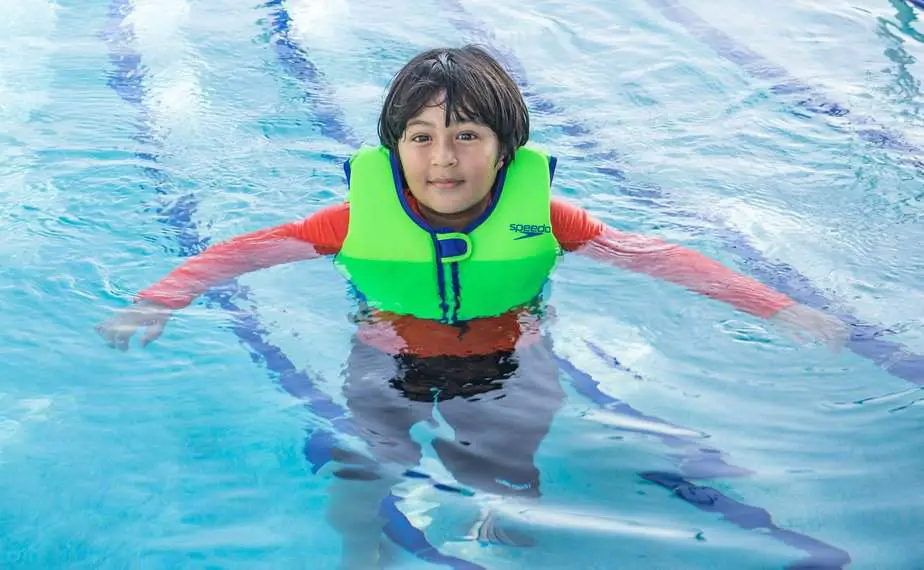
For their safety and your peace of mind, your child should also be using some kind of flotation device such as a flotation belt, snorkel vest, or life vest. Even if your child is going to be snorkeling in shallow waters, a flotation device is good to have as backup.
When snorkeling, it’s really easy to be so enamored by the underwater sights that your child keeps swimming to deeper and deeper waters. Furthermore, sometimes the currents can be really strong and pull your child out to sea. Unless your child is snorkeling in a shallow confined pool of water, a flotation device is highly recommended to keep them safe.
Snorkel and mask alternative: full face snorkel mask
Your kids may find it uncomfortable to hold the snorkel mouthpiece for very long, but perhaps they still want to try snorkeling. You could try looking for a more comfortable snorkel. Alternatively, there is a type of mask design called the full face snorkel mask which, as the name suggests, covers the entire face and eliminates the need for a snorkel mouthpiece.
There are adult full face masks, but also full face masks designed for children as well. By combining the snorkel and mask into one product, you do not have to worry about mixing and matching a mask or snorkel from different manufacturers.
Full face masks are often cheaper than the combined price of a separate mask and snorkel. Furthermore, full face masks come with a dry snorkel built in. A dry snorkel is designed to keep water from entering the tube, even when the snorkel gets submerged, so that there is almost no chance to choke on water.
Lastly, there are some concerns as to the efficacy of full face masks, however the studies concluded that they were no worse than a traditional snorkel and mask combination.
Snorkeling basics for kids
Now that the gear is sorted out, it’s time to learn some tips about snorkeling. It’s important that your children know the basic etiquette that other snorkelers follow in order to be respectful to them and the marine life as well.
Body positioning
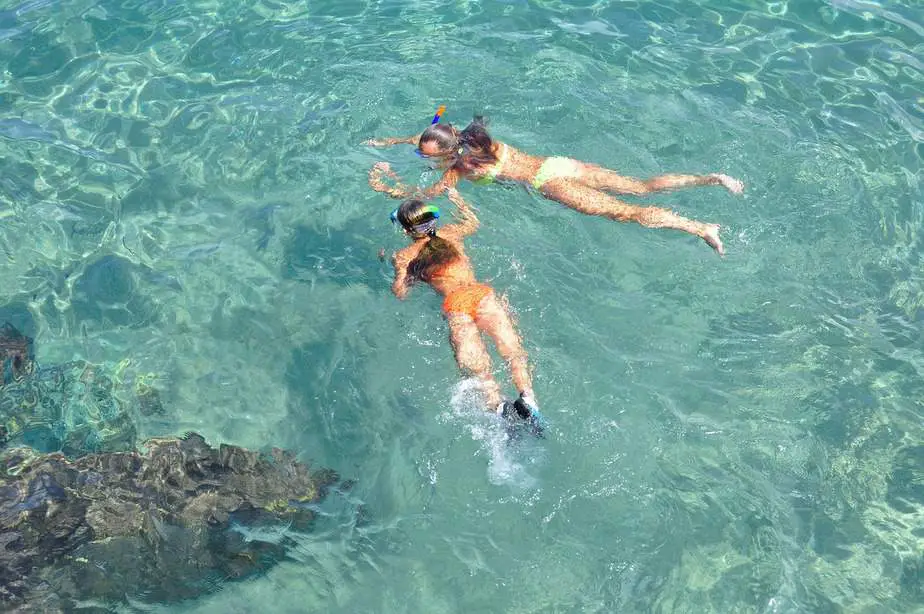
The proper positioning for snorkeling is a relaxed position that is parallel to the surface of the water, with hands to the side, and the head tilted 45 degrees upwards.
The head positioning is crucial. A common mistake beginners make is to keep their head neutral (looking straight downwards). The snorkel is designed to be perpendicular to the surface of the water and this can only happen when the head is tilted slightly upwards.
When the head is in a neutral position, or if the chin is tucked in, then the snorkel will be at a disadvantageous angle where it is nearly parallel to the surface of the water. Water can more easily enter the snorkel and obstruct airflow. Depending on the snorkel type, if the water enters, it can become a choking hazard.
In order to move while snorkeling, instruct your child to kick gently with his/her fins. The arms are unnecessary for movement and should be kept to the side (this also discourages touching). The purpose of snorkeling is to float calmly along the surface while conserving as much energy as possible. For this reason, incorporating arms into the movement is just using up precious energy.
Look, don’t touch
Is your child the kind that likes to reach and grab everything he sees? Kids need to be taught not to touch anything in the ocean. Whether it’s coral, marine life, or other snorkelers, everything is off-limits! Remember the motto: look, don’t touch.
This is important because coral and marine life are dangerous. Corals are sharp and can leave a nasty cut on anyone’s hands and legs. If you or your kids aren’t careful, you guys can end up getting scraped up pretty badly.
A similar comparison can be made to marine life. They may look docile, but they are merely tolerating your presence and will attack if threatened. Some of them may even be extremely anxious and will swim away if you make any sudden movements. That’s no fun for everybody involved. If your kids want to get a good view of marine life, they need to be very calm and gentle to put them at ease.
Stay in the open
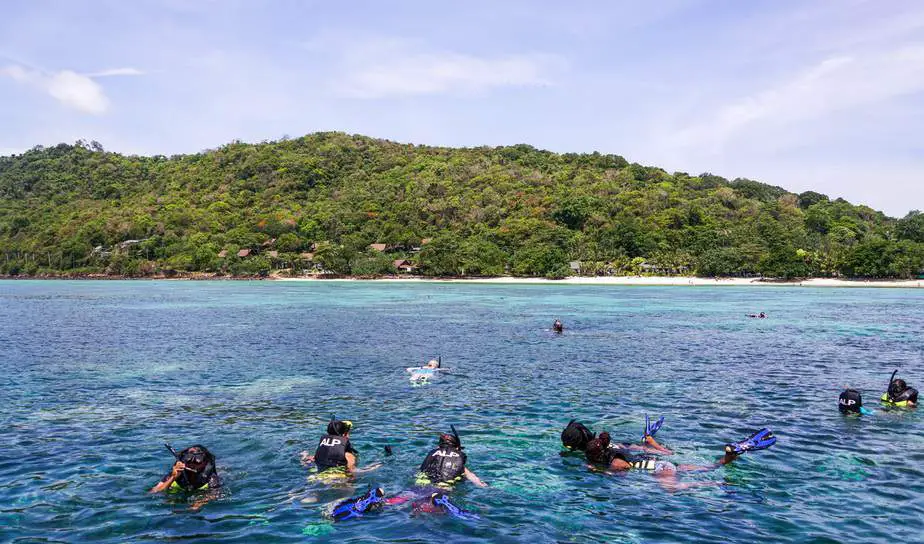
Always keep an eye out for your child, especially if they are the curious and adventurous type. The safest place to snorkel is out in the open. Warn your kids about entering little coves or caves or any other areas that are hard to reach. These are places where it’s really easy to get lost or stuck with no one around to help.
Furthermore, confined spaces such as coves and caves are dark and can cause claustrophobia. They may get lost or find it hard to maneuver when there is so little space. They may panic and find it hard to escape their predicament. Caves are extremely dangerous even for experienced divers and snorkelers, so make sure your child stays out in the open.
Stay calm
What happens when something goes wrong? For instance, it’s quite common for water to enter the mask due to a poor seal. Water will sometimes enter the snorkel and become a choking hazard. Sometimes a child might snorkel out too far and get scared. No matter the situation, the best way to deal with it is by first staying calm.
When a snorkeler panics, then they will waste precious time and energy flailing around. We highly recommend wearing a snorkel vest so that in the absolute worst case scenario, it will keep you or your child afloat so that you can conserve energy and focus it elsewhere.
In the case of water entering the mask or snorkel, for example, all one needs to do to fix the problem is lift the head above the water and take off the mask or snorkel. They can then drain the mask or blow through the tube to clear it. Then simply put the mask and snorkel back on and continue as usual.
However, if they are not prepared for this, then a child may not know what to do and start panicking. The purpose of practicing with snorkeling gear and techniques in a pool is to train themselves so that they don’t panic during the real thing.
Choosing a good snorkeling location

Selecting the ideal snorkeling spot can make or break your snorkeling experience. Based on where you’re vacationing, look for nearby snorkeling spots in advance to find good candidates for your children.
Whether it’s California or the Caribbean, there are many family-friendly destinations all over the world. It’s likely that your hotel or resort offers gear rentals so that you don’t even have to own your own gear. They may also have tours so that you can be with other snorkelers and get access to an instructor.
Make things easy on the family by picking a day with idyllic weather; a warm, sunny day with calm seas and hopefully not too many swimmers. When the conditions are calm, young snorkelers have less to worry about as they snorkel for the first time.
When the currents are calm, it also provides the greatest chances for underwater visibility. The great thing about snorkeling is that your kids don’t need to go very far out to see many schools of fish and vibrant coral.
If you’re with a tour guide, they’ll let you know the best spots to get the greatest views. For instance, bands of rocks along the shore are typically home to many colorful species that are sure to delight your kids. Stick close to your kids and make sure they don’t get too distracted and swim to deeper waters.
Wear sunscreen and anti-UV clothing
The importance of coral-safe sunscreen or sun protection clothing cannot be overstated. If your family will be exposed to sun for 30 minutes or longer, everyone must have some kind of UV protection. The sun’s rays can cause cancer and rapidly age the skin, and of course it can also cause a painful sunburn that can ruin the vacation.
No matter what, wear sunscreen and make sure it’s a broad spectrum sunscreen that is at least SPF-15 or higher. For clothing, make sure you specifically purchase clothing with a UPF rating. Regular clothing does not do a great job blocking the sun’s rays, so get clothing that has an actual UPF rating meaning it will stop the sun’s UV rays.
Even with UPF clothing, there are still areas of skin that are exposed to the sunlight. For instance, the back of the neck, face, and ears are not likely to be covered up. That is why you should always have a reef-friendly, broad spectrum sunscreen to cover up exposed skin.
Apply sunscreen 30 minutes before heading out so that the skin has time to absorb it. This decreases the likelihood of the sunscreen getting washed off by water or rubbed off by clothing or contact with other surfaces. Your kids are not going to be keeping track of the time, but you should help them reapply sunscreen every 30 minutes or as directed by the label on the bottle.
Bring a first aid kit

Scrapes and bruises are almost a guarantee if your kids are active and eager to explore what life has to offer. As a parent, no matter how watchful you are, there are times when your children get injured. That’s why it’s important to have a first aid kit on hand. Having a back-up in case things go wrong is always a good idea, particularly since coral and rocks are very sharp.
Your first aid kit should have the standard antiseptic solution, ointment, and band-aids. We also recommend you add hydrogen peroxide and a pair of tweezers in case your kids touch something that gets under their skin.
Furthermore, if your kids have any allergies, you should have the proper protocols for if they suffer an allergic reaction. This is also the reason why travel insurance that also covers for accidents that occur when snorkeling is so important if you’re traveling abroad. In the worst case, you want to know that you can give your children the best medical care possible without ruining you financially.
Parting words
Snorkeling can be a great family activity that the family can bond over. It may take a while for your kids to acclimate to breathing underwater, but once they do, then they can experience the beautiful reefs of beautiful snorkeling destinations like Florida or Maui.
Below the waters are a cornucopia of color and life that many people never had the pleasure to see first hand. Pictures and videos don’t do it justice. You have to actually be there. This beautiful world is just waiting to be explored.
The risks of snorkeling are fairly low. To make it even safer, parents can take their kids snorkeling at resorts that cater to snorkelers. With some preparation, the whole family can be snorkeling in a safe, idyllic environment, breathing the open air from underwater.
As long as everyone follows the snorkeling guidelines such as staying in open waters, keeping hands to themselves, wearing a flotation device, and staying calm, then snorkeling is hardly a dangerous activity. With that said, parents, don’t let your kids out of your sights! Stay close to them at all times, otherwise they might get into trouble.
It’s also a good idea to ask the hotel concierge or locals about the weather conditions and any tips they have about the beaches. After all, they are trained to stay up-to-date on the latest nautical and weather conditions. Once you have your snorkeling gear in hand and these tips firmly ingrained in your head, then it’s time to head out into the water with your kids and have fun.
Photo Credits: kbossey CC BY-ND 2.0

